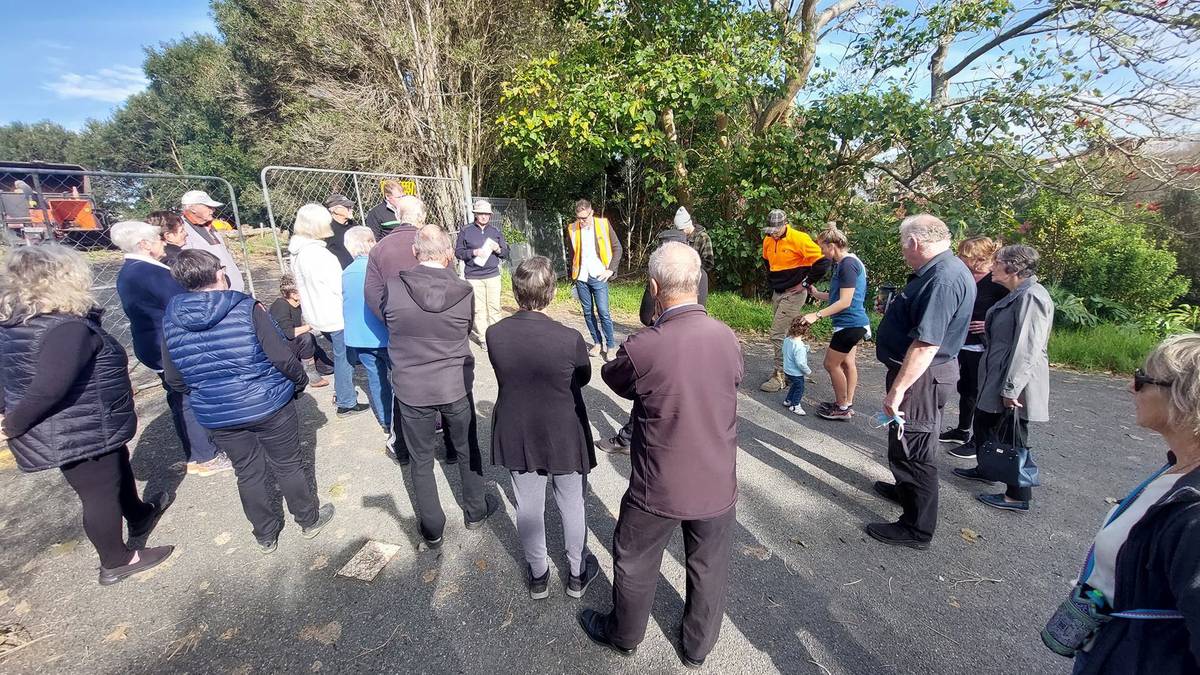Trustees of the Kamo Home and Retirement Village Charitable Trust reveal their plans for an 18-lot subdivision to the Onerahi community. Photo / Supplied
Onerahi is set to expand with a new 18-lot subdivision at the old St Mary’s Hospital site – a prime property location that has been sitting vacant for more than two decades.
Onerahi
residents have been noticing movement on the 1.85ha of land at the end of St Marys Place since May and now property owner Kamo Home and Retirement Village Charitable Trust has finally shed light on the mystery.
Chairman John Williamson said it was a “brilliant site for housing” and the trust would lodge its resource consent application this week.
“We bought the land in December 2019 with the objective to build retirement care facilities,” Williamson explained.
“We went through an extensive process to determine the feasibility of building an aged care facility.”
However, the land was too small for a comprehensive aged care facility and yet too big for a specialised care unit.
“We celebrated our 50-year anniversary last year – we’re in the business of providing aged care and we expect to grow and meet the needs of the community.”
Even though they would have “absolutely preferred” retirement facilities, the charitable trust didn’t want to commit to a high-risk development so the group opted for a safer choice.
/cloudfront-ap-southeast-2.images.arcpublishing.com/nzme/4IJ632MNC25DNBTHVDESVERZX4.jpg)
Should the resource consent be granted, the subdivision would be constructed along a cul-de-sac connecting to St Mary’s Place with two shared driveways to access sections.
Of the 18 lots, seven smaller ones are sized from 330-457sq m, eight mid-size lots are between 522sq m and 726sq m, and three larger sections are from 962-1271sq m.
There will be on-site parking for two vehicles per lot.
An 8300sq m section of bush on the north-western edge would be collectively owned by everyone in the subdivision.
Beautification options are limited due to the site’s steep nature but Williamson said it planned to pave some paths through the vegetation and possibly connect a walking path through to Whangārei Heads Rd.
Williamson said the design of the subdivision aimed to be user-friendly for the residents and for those providing and maintaining services.
“We also want to make sure the neighbours are happy with everything we do.”
To achieve that, the trust organised a community meeting on site last week and answered various queries from local residents.
Whangārei District Council’s Okara Ward councillor Nick Connop said the meeting was positive and drew a crowd of about 25-30 people.
“I think the organisers were surprised by the interest in the development,” Connop said.
“There was a lot of concern initially but by the end, people were very happy and grateful with how they [the trust] responded to their questions.”
Connop said most concerns were around traffic and how the increase of residents would impact the traffic flow coming from and going to Whangārei Heads.
/cloudfront-ap-southeast-2.images.arcpublishing.com/nzme/NNT36RDYX27AFG643BRTXHD4XM.jpg)
The subdivision is expected to add around 200 vehicle movements a day to Whangārei Heads Rd which would result in “negligible effects on the existing operation of traffic on the surrounding network during peak times”, a traffic assessment report says.
Another talking point was the runoff from the property. The site was prone to flooding and water currently runs off to adjacent properties.
Houses located at the bottom of the slope that borders St Mary’s have been especially affected by runoff and earth movements.
All of this was taken into account in the resource consent application.
Connop said the trust was aware the development would have an impact on Onerahi and its residents.
“The trust is trying to do the best for themselves and also the community.”
Over the two decades since St Mary’s Hospital was decommissioned the property has gone through the hands of several owners.
/cloudfront-ap-southeast-2.images.arcpublishing.com/nzme/4WD3ZHIGO3IAEG64KSL643E2FE.jpg)
In 2004, plans for a 36-apartment complex with two three-storey buildings and a recreation section were granted resource consent after Environment Court involvement but the consent lapsed and the luxury dwellings were never built.
Three years later, the vacant hospital buildings were half destroyed by fire. The ruins were later cleared by a property owner.
When the Kamo trust took over in late 2019, there was only a concrete pad left on site.
“It’s been a bit of a mess,” Williamson said.
“We want to leave the place better than we’ve found it.”
/cloudfront-ap-southeast-2.images.arcpublishing.com/nzme/XN5E43MBKCLW6ASPYNZZER2PPA.jpg)




